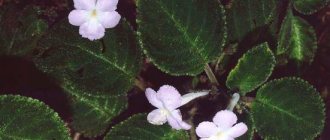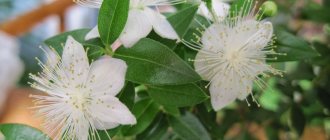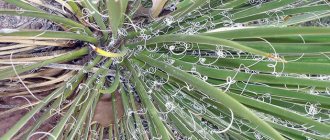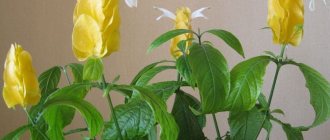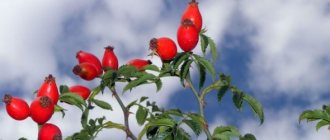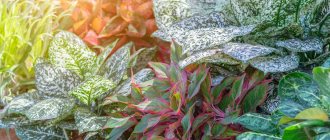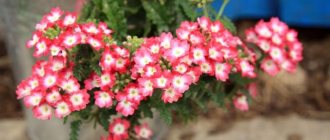Sansevieria or Sansevieria is one of the champions in oxygen production among houseplants; at the same time, this plant absorbs substances harmful to health from the air. For its striped, hard and long leaves, Sansevieria has received the popular name “pike tail”. Sansevieria is unpretentious in care and is successfully grown by novice gardeners. This plant is very decorative, looks impressive indoors, and is often grown at home, in offices and winter gardens.
basic information
Much has changed since the unprecedented popularity of this flower; a huge number of more spectacular and exotic “pets” have appeared, displacing Sansevieria on its pedestal. However, breeders did not leave “mother-in-law’s tongue” without attention and, based on it, developed many decorative, hybrid forms that attract interested glances.
This evergreen stemless plant belongs to the Asparagus family and the flower genus consists of almost six dozen species. You can meet it in its natural environment in Asian and African deserts, semi-deserts and savannas. As a house plant, flower growers grow it in different parts of the world and everywhere Sansevieria is given another, poetic name, calling it “pike tail”, “leopard lily”, “cuckoo tail”, “Indian sword”, “snake skin” and even “African hemp" and "the tongue of the devil." In addition, there are several Latin variants, in addition to sansevieria these are sansevieria and sansevieria.
Features and names of the plant
Officially, the genus Sansevieria is named after Prince Sansevero (von Sanseviero), an Italian scientist and inventor of the 18th century. Among the people, this plant has acquired so many names like no other.
In Russia, Sansevieria, “pike tail”, and “mother-in-law’s tongue” are often used. The British call it snake plant, “leopard lily” and even “devil’s tongue”. For Americans, Sansevieria has become snakeskin. And in German-speaking countries it is called “African hemp,” recalling the origin of the succulent from the arid regions of tropical Africa.
The characteristic shape and pattern of leaf blades are decorative features of plants of this genus. Conventionally, a group of species is distinguished with long leaves and short ones, similar to a wide dagger.
Description of the plant “pike tail”:
- succulent with linear or ovoid leaves collected in a rosette;
- leaf blade dimensions: length from 0.2 to 2 m, width - up to 7 cm;
- leaf color - different tones of green; there are patterns in the form of uneven stripes and spots that are clearly visible in photographs of varieties;
- the leaves have a pointed tip, which gave rise to the name “flowers - mother-in-law’s tongue”;
- medium-sized buds are collected into a raceme inflorescence;
- corollas are greenish-white, fragrant, 3–5 cm long.
Sansevieria flowering in temperate climates is a rare occurrence. With good care, sometimes you can admire how Sansevieria blooms indoors. Greenish-white flowers appear on older plants and open fully at night.
In tropical and subtropical countries, every year you can not only observe, but also feel - senseevieria blooms profusely and exudes a pleasant aroma of vanilla.
Indoor plants with a subtle aroma: Murraya, myrtle, coffee tree.
Aboriginal people use Sansevieria leaves to obtain strong plant fibers. They make bow strings, ropes, ropes and coarse fabrics.
The plant really attracted the attention of air cleanliness activists. Various studies have confirmed the ability of sansevieria to neutralize toxic substances. An indoor flower absorbs carbon dioxide even at night, when other plants only absorb oxygen for respiration, and photosynthesis with the release of O2 does not occur.
Beneficial properties of sansevieria
Sansevieria perfectly purifies the air from various harmful impurities. In particular, it effectively removes benzene and trichlorethylene. To significantly improve the environmental situation, only 2-3 medium-sized plants are enough. They can be placed in any room, except the bedroom. Also, the “pike tail” secretes phytoncides that destroy pathogenic microorganisms.
The long leaves of the plant are often called “mother-in-law’s tongue.” According to some superstitions, they encourage people to gossip. In fact, everything is exactly the opposite. Sansevieria has the ability to cleanse the surrounding space of various negativity, helps achieve set goals, and develops entrepreneurship in people.
What kind of land do you need for growing outdoors?
Sansevieria grows well in open areas.
Transplanting into an open area improves the appearance of the flower and increases the speed of its reproduction (we talked about the rules for propagating sansevieria and further caring for it here). To grow outdoors you need :
- Take 3 parts of turf or leaf soil.
- Combine them with 1 part of sand.
- Add 1 teaspoon of humus (humus).
A recipe of one part turf soil, one part leaf soil and one part sand and peat is also suitable.
Reproduction
Sansevieria at home is most often propagated vegetatively: by dividing the bush (lateral layering), dividing the rhizome or leaf cuttings.
When dividing a bush, the rhizome connecting the parent plant with the shoot is cut with a sharp knife; this rhizome is quite strong. The cut is sprinkled with crushed coal, placed in a separate pot with fresh soil, and watered. In the future, watering should be careful, not excessive. You should refrain from feeding for a month. As a rule, layerings take root well.
It is more difficult to propagate sansevieria by leaf, but the advantage of this method is that you can get several new plants at the same time.
Leaves for cuttings must be sufficiently mature and healthy. Usually the old lower leaves are taken. Leaf cuttings 5-10 cm long are dried in air for two days, then placed vertically in damp sand, peat or vermiculite, buried by 1.5-2 cm. A distance of 2-4 cm is left between the cuttings. The soil is lightly compacted so that the cuttings stayed in it. Cover the top with a jar or bag, removing them once a day for ventilation, and moisten the substrate as it dries. The container with the cuttings is placed in a bright, warm place without direct sun.
After about 2-3 weeks, roots appear on the cuttings, after 1-2 months - babies, after 2-3 months - stem cuttings, which can be planted in separate small pots. Water carefully, without flooding.
Important: when variegated varieties of Sansevieria are propagated by leaves, the varietal characteristics of the parent - colored stripes on the leaves - are not transmitted to the daughter plant. Therefore, it is better to propagate such species by dividing the bush.
Another way to propagate sansevieria is by dividing the rhizome. For propagation, take an adult plant with a developed rhizome. Dry roots are peeled off the rhizome and cut into pieces, each with at least one bud. The sections are treated with a fungicide or sprinkled with crushed coal and placed in the substrate.
Soil preparation
Sansevierias are replanted once a year, if the plant is still young. If the sansevieria is more than two years old, then the transplant is carried out once every three years. It is best to replant in the spring. The indoor plant has a very extensive root system, so the pot must be selected taking into account the fact that the roots will grow and may begin to destroy the container. In order to prepare the soil for transplanting sansevieria, you need to take four parts of leaf soil, one part of turf soil and one part of sand. It is also possible to add peat or humus. It is necessary to ensure very good drainage for the plant.
Errors when leaving
The main reasons for the wilting and death of Sansevieria are the following:
| Error | Consequence | How to fix |
| Much water. | Root rot extending upward. Death of the plant. | Removing damaged parts of the plant, replanting, limiting water. |
| Hypothermia. | Lethargy. | Circumcision, moving to a warm room. |
| High humidity. | The appearance of brown spots. | Removal of affected organs, exposure to sunlight. |
Planting and further care
Sansevieria is unpretentious and requires minimal care at home. The plant easily tolerates moisture deficiency, so watering should be moderate. Make sure the soil has time to dry. In winter, watering once a week is sufficient. It is important not to pour water into the center of a bunch of leaves, as this can lead to the formation of crusty spots and further rotting of the leaves. But, the cut leaves of the plant can be placed in a vase with water if the situation requires it. At the same time, Sansevieria will be able to stand in the water for some time and not rot, even take root and continue to grow, but this will not last long. It should also be noted that sansevieria calmly tolerates watering with hard water and the high lime content in the soil does not bother it.
Pots with sansevieria can be placed near heating radiators; the plant also tolerates summer heat well. As for the cold, a temperature of +8 degrees is considered the minimum for normal growth of sansevieria. The plant loves light very much, but can live in the shade for some time. In winter, it is better to choose a bright room for sansevieria. If such a need arises, you can feed the sansevieria with regular fertilizers for indoor plants. But it's important not to overdo it. It is believed that with excessive feeding, the leaves may fade and lose their bright color. This indoor plant does not require spraying at all. It is enough to occasionally wipe the leaves of the plant with the soft side of a damp sponge.
Diseases and pests
When caring for a pike tail flower, the least thing you should worry about is pests. Even scale insects don’t like hard leaves. The danger for this resistant plant is “care diseases”. When the soil in the pot becomes waterlogged and water gets into the rosettes of the leaves, rotting begins. Sansevieria becomes more susceptible to fungal and bacterial infections.
Measures to save the plant - emergency replanting with removal of rotten parts. In the future, correction of care will be required, compliance with the rules of watering, temperature conditions and fertilizing.
Sansevieria is a very persistent plant that feels good in living rooms and is used to decorate offices, shop windows, and exhibitions. In large rooms, pike tail is planted in long containers or boxes placed on the floor. In order to emphasize the unusual coloring of the leaves, light gravel and shell rock are poured on top of the substrate. You can add living stones to them - lithops. Sansevierias look beautiful against the background of uneven stone walls, brickwork, and natural stone.
Popular decorative foliage plants:
- Syngonium
- Tradescantia
- dollar tree
- Dieffenbachia
Types and varieties
Sansevieria grandis (Large)
The plant is a perennial, the rosette is usually formed from 4 leaves, the length of which varies from 35 to 70 cm. The width of the leaf can reach up to 17 cm. The leaves have a pattern in the form of darkish transverse stripes, the edges of the leaf have a reddish border.
Sansevieria hyacinthoides (Hyacinth)
The height of the plant reaches up to 60 cm, the leaves are arranged in a rosette containing 3-4 leaves. The length of the leaves varies from 12 to 45 cm, the width is no more than 8 cm. The leaves have a lush green color with the inclusion of light wavy strokes. The edges of the leaves are colored light or reddish.
Sansevieria dooneri (Dooneri)
A plant with rosettes which usually have from 16 to 20 leaves. The length of the leaf reaches 40 cm, the width is quite scanty, only 3 cm. The leaves are rich green with a small pattern in dark colors.
Sansevieria gracilis (Graceful)
A perennial plant, its height reaches up to 6 cm. The leaves are green, oval in shape and slightly pointed towards the end. The leaves have a pattern in the form of grayish transverse streaks.
Sansevieria kirkii (Kirki)
A plant with a weak root system; the rosettes contain a small number of leaves. The color of the leaves is bright green with a light pattern and red edging along the entire perimeter of the leaf.
Sansevieria liberica (Liberian)
A plant with large rosettes, inside of which there are up to 6 leaves. The long leaf can reach more than 1 meter, the width is no more than 9 cm. The leaves are dark green in color, with a bright and light pattern in the form of blurry strokes. The edge of the leaves always has a brown or white edging.
Sansevieria trifasciata (three-banded)
Quite a strong and tall plant, with green leaves and a yellow border around the entire perimeter. There are quite a lot of leaves in the rosette.
Description
Many species do not have a stem: the leaves growing from rhizomes are collected in a rosette. The shape is unique for everyone: long and short, ellipsoid or round, sword-shaped, pencil-shaped and even spoon-shaped. The leaves grow vertically upward, but there are varieties in which growth is directed horizontally. Shades of color vary from dark green to light brown, with the possible presence of light stripes. The top is crowned with a point, which is not recommended to be broken off. The growth rate also differs among different subspecies: some grow quickly, while others will not show more than three shoots in a year.
Growing problems
There are no big difficulties when growing sansevieria; it is a very flexible plant. But sometimes some problems may arise.
Dark spots on the leaves are due to waterlogging at low temperatures.
The leaves are turning yellow. The plant does not have enough light. Perhaps the pot is too tight.
The leaves are soft along their entire length and bend in half or deviate greatly from the vertical. Most likely, the sansevieria does not have enough light, so the leaves are very elongated and cannot support their own weight.
The leaves become soft at the base and begin to turn yellow. Perhaps water got into the center of the outlet and a fungal disease began.
The tips of the leaves wither, turn yellow and dry out. The plant is too cold, it may be overwatered or there is not enough light.
The leaves are withering. The plant has not been watered for a long time.
Why doesn't Sansevieria grow?
If Sansevieria grows too slowly, or has stopped growing altogether, it is worth understanding the causes of this problem. As a rule, the problem appears due to improper care or the presence of diseases in sansevieria.
Cinquefoil - propagation for planting
Thus, Sansevieria will not grow in soil that is too wet or too acidic, in the absence of abundant light or inappropriate temperatures. These factors usually do not lead to the death of this plant, since it is quite resistant to environmental influences and unpretentious, almost like a cactus. However, it will definitely stop growing.
If the question arises as to why the leaves of Sansevieria curl, it is most likely due to insufficient watering. The leaves curl due to lack of moisture and begin to dry out. To avoid curling, you need to water the flower as needed. Those leaves that curl too much need to be trimmed.
In addition, the leaves may become soft. This effect appears precisely due to waterlogging. To avoid this problem, you should not water the flower in cold temperatures, or before the soil has completely dried out after the previous time.
Note! For this plant, it is very important to find the golden mean in terms of moisture: there should be neither too much nor too little. Once the watering situation improves and the soil becomes optimal, the plant will return to its normal appearance.
Unfavorable conditions can not only curl the leaves, but also make them limp. For example, due to the fact that the plant was exposed to too low temperatures. In this case, in addition to softness, they will noticeably darken. To eliminate the situation, damaged leaves must be removed and the plant moved to a warmer place.
Leaf disease
Thus, Sansevieria is a very common flower that has become actively widespread due to its beauty and beneficial properties, as well as the fact that it practically does not require special care. It can be grown not only indoors, but also in open ground, if the climate permits. Piketail is easy to propagate, and if you follow a few guidelines for its maintenance, you can quickly and easily grow an interesting and spectacular plant.
Coffee capsule Nescafe Dolce Gusto Chocochino, 3 packs of 16 capsules
1305 ₽ More details
Hot chocolate capsules Nescafe Dolce Gusto Chococino, 8 servings
334 ₽ More details
Curtains for the living room
Caring for Sansevieria at home
Lighting
Sansevieria will not die in low light conditions, but you should not constantly keep it in the back of the room. For a plant to be beautiful, with developed and bright leaves, it needs a lot of light, including sunlight. Only if the plant is placed on a south-facing window will it require shading on hot summer days.
For variegated varieties, the lighting requirements are somewhat different. If the proportion of yellow in the color is large enough, the plant needs less light; its excess can turn variegated leaves into ordinary green ones. But in low light conditions the plant will develop poorly, so for such varieties you need to choose an intermediate position relative to the window. Be sure to protect them from direct sun, as the colored areas of the leaves are more susceptible to sunburn.
Temperature
The plant is not very picky about temperature; Sansevieria feels most comfortable at 16-20 degrees at night, and 21-28 degrees during the day, but can withstand higher temperatures. If you are in cool conditions for a long time (for example, in winter in the passages of office buildings), you need to significantly reduce watering.
Watering
Sansevieria is a drought-resistant plant, succulent. Water it lightly; the next watering should be done when the soil dries out. The plant can withstand relatively long periods without water.
When watering, you need to make sure that water does not get inside the outlet, which could rot.
When the room temperature is low, Sansevieria needs to be watered less frequently; less frequent watering is also required if the plant is placed in the shade.
Sansevieria does not need spraying, but periodically you need to clean the leaves from dust using a cloth or a special broom.
Transfer
Sansevieria is replanted as the plant grows. Young plants can be replanted annually, adults - once every few years, when the pot becomes crowded. The new pot is shallow, 1.5-2 cm wider than the old one, sansevieria does not like a large volume of soil, and its root system is superficial and shallow.
Sansevieria needs light, low-nutrient soil that dries quickly. It is better to use specialized soil mixtures for cacti and succulents or make your own soil from leaf, turf soil and sand in equal parts. If the soil is prepared independently, it is advisable to calcinate it in the oven or steam it.
Top dressing
From May to September, sansevieria is fed once every 2 weeks. The rest of the time, you can apply fertilizer once a month, but during cool wintering you should not feed the plant at all. For feeding, use fertilizers for cacti and succulents or universal mineral fertilizer. For variegated varieties, do not use fertilizers with a high nitrogen content, which stimulates the production of chlorophyll and, as a result, greening of the leaves.
Lighting
Despite the fact that Sansevieria tolerates shade and partial shade well, the best place for it is a place with an abundance of sunlight. She only needs shading in such a place on hot sunny days.
For variegated varieties, this guarantees bright, rich leaf color.
In winter, it is advisable to organize additional lighting.
! For varieties with a yellow color, the lighting should be diffused. When exposed to direct sunlight, the color of the plant may change to completely green.
For uniform growth of the plant, it must be periodically turned to the light with the other side.
Medicinal, beneficial properties of sansevieria, “mother-in-law’s tongue”, “pike tail”
Healing properties of sansevieria (“mother-in-law’s tongue”, “pike tail”). Treatment of colds, treatment of otitis media, treatment of gastrointestinal diseases.
Sansevieria is native to Africa and tropical Asia, where it grows in savannas, semi-deserts and even deserts. Sansevieria is an unpretentious stemless plant of the lily family; it has erect, sharp, lanceolate, dense, dark green basal leaves up to 1 m or more long, with transverse yellowish or light green stripes. The rhizome is creeping, powerful. Sansevieria blooms with fragrant, sticky nectar-producing pale green flowers, almost white, with narrow petals and long stamens. The flowers are located on a long peduncle-arrow.
Sansevieria contains a number of biologically active substances, but the most important of them for humans are saponins - highly toxic substances that, when used properly, can bring great benefits.
In traditional medicine, saponins are used in the production of laxatives, choleretic, expectorants, and anti-inflammatory drugs. In folk
In medicine, sansevieria is used for cystitis and adnexitis, otitis, and inflammation of the throat and oral cavity. It helps increase immunity, stress resistance, and improve the general condition of the body. You can use it for cuts and bleeding. For scratches and other shallow damage to the skin, it is recommended to apply a sansevieria leaf with the side from which the skin was previously removed to the affected area. The plant, like plantain, will disinfect and stop bleeding.
Saponins are glycosides of plant origin with surfactant and foaming properties. They are practiced in cosmetology in the manufacture of detergents such as shampoos, liquid soap, etc.
It is not recommended to use sansevieria in treatment during pregnancy, since it is believed that the substances contained in this plant have abortifacient properties.
Soil composition
For pike tail, it is better to choose moderately fertile, loose, slightly acidic .
From ready-made soils, a soil mixture for cacti and succulents , and for self-production - one of the following compositions:
- two parts of leaf soil, half of humus, one part of turf soil, peat and sand;
- one part turf, one part leaf soil, two parts coarse sand;
- three parts of turf land, one each of peat and sand.
You can also add perlite, vermiculite, brick chips, pieces of charcoal and a small amount of bone meal to the main types of soil for sansevieria.
Sometimes sansevieria is planted in compositions of ampelous and ground cover plants. In this case, so that the not too intensively growing “pike tail” can withstand competition with more aggressive species, a nutrient substrate of the following composition is suitable for it: three parts of turf soil and one part each of peat, coarse sand and compost.
